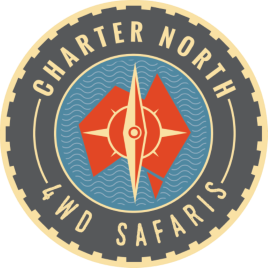Tourism in the Kimberleys has developed mainly unplanned. The Kimberley Science and Conservation Strategy aims at managing the impacts of tourism as part of a broad conservation approach for the region.
The sustained and ongoing growth of the tourism industry worldwide since the 1960’s has raised concerns in terms of its negative impacts on destination environments and host communities. Nature- based tourism has experienced an especially high growth rate, often in the absence of associated planning frameworks. Therefore, sustainable tourism planning and development have become increasingly important and we enthusiastically welcome and support any projects, programs and governmental initiatives that work towards this.
At Charter North, as a business that recognizes its ecological and ethical responsibilities, we are always keeping an eye on any environmental and social developments at the destinations we visit.
The Kimberley Science and Conservation strategy is an example of an integrated conservation approach that we think has been long overdue. Even though the strategy mainly encompasses conservation activities, it also incorporates tourism infrastructure upgrades that improve visitor experiences while protecting the natural environment from negative impacts through visitation. It also creates ongoing local employment, which is extremely important in the remote areas of the Kimberley that have limited economies. Read on if you would like to find out more about the Kimberley Science and conservation Strategy.
The Kimberley Science and Conservation Strategy (KSCS) is the first integrated management strategy for the Kimberley Region that incorporates tourism alongside other topics. The strategy was developed in 2011 by the state government of Western Australia, who initially invested AU$63 million over five years into conservation projects. The budget has since been raised to over AU$80 million and funding will be ongoing. Most initiatives as part of the Kimberley Science and Conservation Strategy are conservation initiatives dedicated to the management of fires, feral animals and weeds and the establishment of protected areas. However, the strategy also incorporates a number of tourism related projects.
The Kimberley Science and Conservation Strategy strongly promotes and highlights the natural values of the Kimberley Region and its potential to become a world class ecotourism and cultural tourism destination.
“The strategy recognises that the Kimberley has the potential to become one of the world’s greatest wilderness ecotourism destinations – a place where extraordinary natural and cultural values can be experienced with confidence that they are fully protected” (KSCS 2011, p. 5).
“It is […] expanding eco-friendly nature-based tourism to ensure more people have the opportunity to appreciate the region’s outstanding attributes and to generate employment and cultural tourism opportunities for Aboriginal communities” (Department of Parks and Wildlife).
Tourism Western Australia, in partnership with the Department of Parks and Wildlife and the Department of Regional Development and Lands, are responsible for implementing the tourism initiatives of the strategy. An initial AU$5.8 million of the strategy’s total budget were allocated for tourism related projects, such as upgrades and expansion of visitor facilities as well as the development and promotion of tourism corridors, 4WD expedition trails and the Kimberley Aerial Highway.
The strategy also incorporates assistance for Aboriginal communities in the development of naturebased and cultural tourism services.
Furthermore, the Kimberley Wilderness Parks, the largest interconnected system of marine and terrestrial parks in Western Australia, covering 3.5 million hectares, will be developed. Most of these parks won’t be accessible by tourists, but they are believed to contribute to the promotion of nature- based tourism in the area. New National Parks will be managed jointly with traditional owners. Information regarding implemented tourism and conservation initiatives of the strategy is available through the website of WA’s Department of Parks and Wildlife. Upgrades have been undertaken in many National Parks, for example the iconic Purnululu National Park (Bungle Bungles) and Mitchell River National Park.
All of the tourism infrastructure upgrades as part of the Kimberley Science and Conservation Strategy are designed to improve visitor experiences and access, while maintaining conservation values of the region. They are carried out in corporation with local Traditional Owners and indigenous groups whenever possible.
As part of the tourism component of the strategy, there has also been made an effort in providing increased indigenous content in the Kimberley to add to the tourist experience. For example, newly installed signage at Tunnel Creek National Park outlines the famous history of the aboriginal resistance fighter Jundamarra who used Tunnel Creek as his final hideout, while also informing visitors about recommended eco- friendly behaviours in the park.
The Kimberley Science and Conservation Strategy also incorporates the development of cultural tourism products in corporation with local indigenous groups with the aim of realising cultural tourism opportunities in the Kimberley Region. Tourism Western Australia is currently responsible for implementing this part of the strategy, and have appointed the Western Australian Indigenous Tourism Operators Council (WAITOC) to carry out a four year long Aboriginal Tourism Development Program. A Business Development Officer has been appointed to work with and support new and existing indigenous tourism enterprises participating in the program. The ultimate aim is to create self-sustaining businesses that create sustainable employment and income opportunities for indigenous people, while providing visitors with special cultural experiences.
The KSCS has already led to improvements to the tourist infrastructure and facilities in the Kimberley, and is likely to further increase the recognition and exposure of the region as an eco- friendly and cultural tourism destination. The strategy will be an ongoing initiative with a further AU$9 million investment in 2015/16.
You can download and read the full document of the Kimberley Science and Conservation Strategy here.
It is exciting to see that the government and its partners are making an effort to protect the beautiful natural environment of the Kimberley while making and effort to involve the indigenous population and create local employment. It will be interesting to see the outcome of current projects and further initiatives in the future. Of course, the Kimberley Science and Conservation Strategy incorporates a whole variety of conservation initiatives. If you would like to find out more, the Department of Parks and Wildlife is a good starting point.


